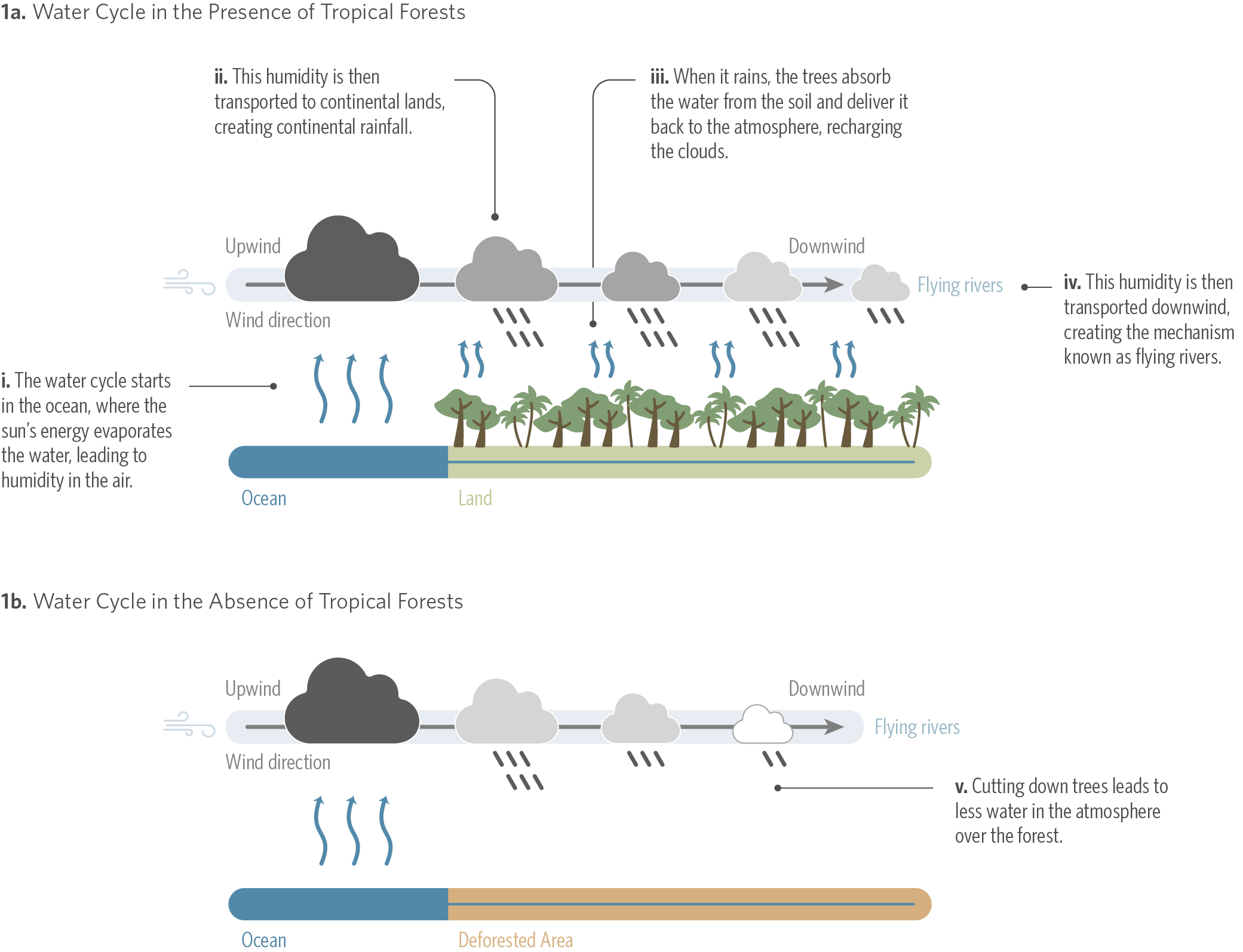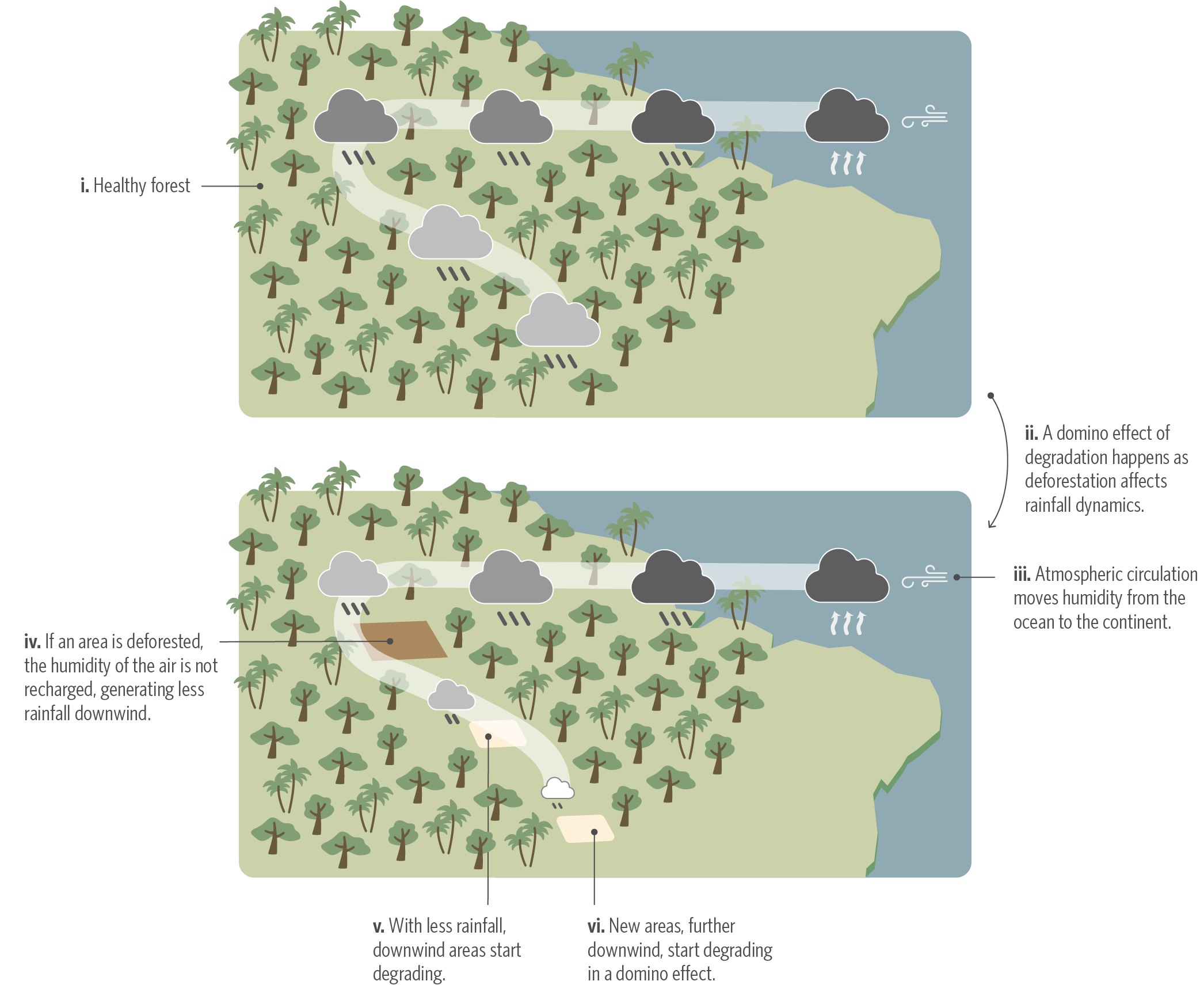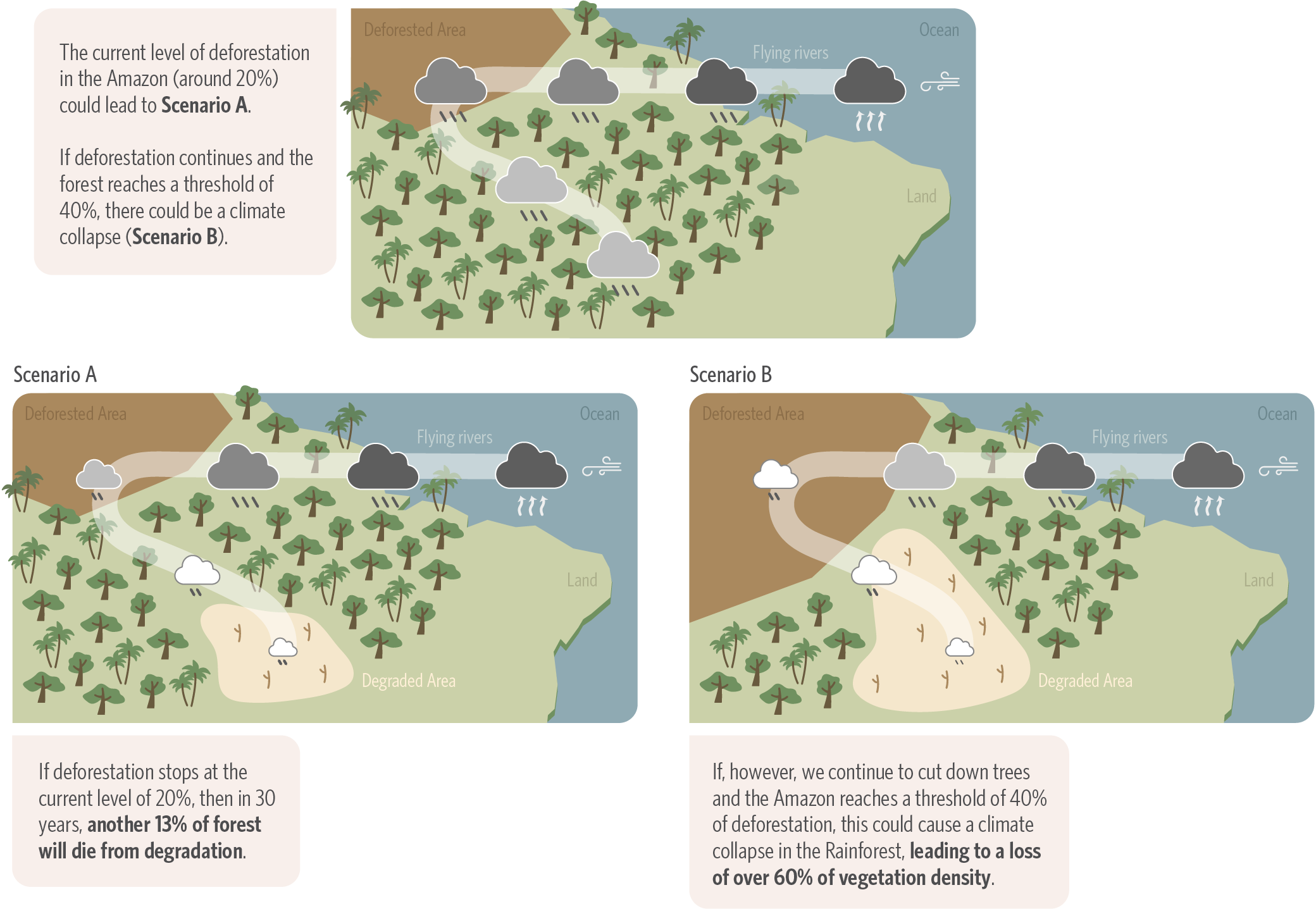The Amazon Rainforest could be on the verge of reaching a tipping point from which most of its vegetation would be lost, causing a climate collapse with a series of devastating environmental, economic, and social effects. The loss of its 400 billion trees alone would emit as much carbon as five years of global emissions, effectively making it impossible to limit global warming to 1.5°C.
A 1990 study that simulated the effects of deforestation on the Amazon climate first indicated the possibility of a tipping point.[1] Findings showed how the extent of deforestation in the Amazon could potentially lead to a widespread degradation process, affecting the stability of the ecosystem and resulting in the loss of most of the forest’s vegetation.
Since then, evidence of an Amazon tipping point has increased.[2],[3] Certain parts of the forest are already showing signs of instability, losing their ability to recover after dry spells.[4] Moreover, some regions have shifted from being a carbon sink to a carbon source,[5] a possible fate for the entire forest in a tipping point scenario.
In this publication, researchers from Climate Policy Initiative/Pontifical Catholic University of Rio de Janeiro (CPI/PUC-Rio) present unprecedented results on the impacts of deforestation in different regions of the forest, through the simulation of millions of hypothetical scenarios over the next 30 years. They use a climate-forest model to identify that, on average, for every 100 trees deforested, 22 additional trees die in regions distant from the deforestation due to lack of water.
Thus, the impact of deforestation is not constrained to the deforested area. Public policies designed to reduce deforestation and incentivize restoration should account for these spillover effects. Effective conservation policies must go beyond a narrow scope of deforestation reduction and consider targeting priority regions that will maintain the equilibrium and resilience of the rainforest to avoid its tipping point.
THE STATE OF THE FOREST
Tropical forests offer a range of ecosystem services from regulating water cycles to protecting against extreme weather events.[6],[7] Its centrality for the water cycle is such that makes its conservation critical for rain-dependent economic activities, such as agriculture and energy generation. Additionally, the Amazon has the greatest concentration of biodiversity in the world and is central for the livelihood of traditional populations. The repercussions of an Amazon collapse would be felt locally, nationally, and around the globe.
Despite its significance, the Amazon Rainforest continues to face considerable pressure. Deforestation rates have increased over recent years, leading to a nearly 20% loss of the Amazon’s original area.[8] The remaining forest is not entirely preserved, because at least another 20% has been impacted by degradation, meaning that it has lost some of its vegetation and is therefore less able to provide critical ecosystem services, particularly carbon sequestration and storage.[9]
Degradation poses a significant threat to the integrity of the forest. Degradation accounted for nearly 70% of global carbon emissions from tropical forests between 2003 and 2014, while deforestation accounted for the remaining 30%.[10] Forest degradation occurs in various ways—forest fires, selective logging, and deforestation itself all contribute to forest degradation by compromising the integrity of the vegetation.
Deforestation may drive degradation and accelerate the pace of additional forest loss beyond what is currently measured. One way in which this happens is through border effects. After an area is deforested, the vegetation along the new forest border becomes exposed to atypical conditions, such as changes in temperature, light, and wind. This may interfere with that ecosystem’s local equilibrium and trigger the onset of degradation.
Another potential avenue in which deforestation drives degradation is through changing rainfall patterns that can cause degradation to occur in areas far from deforested regions. This publication demonstrates how the connection between deforestation and degradation occurs and offers a potential explanation for why a relevant share of the degradation appears far from deforested areas.
THE DOMINO EFFECT: DEFORESTATION, RAINFALL, AND DEGRADATION
A domino effect connecting deforestation and degradation results from the relationship between the forest and the water cycle (Figure 1). The water cycle starts in the ocean, where the sun’s energy evaporates the water, leading to humidity in the air. This humidity is then transported to continental lands leading to precipitation. Water from the precipitation stays underground and/or goes to the rivers, eventually returning to the ocean, closing the cycle. But this dynamic is completely changed in the presence of a tropical forest. When it rains, the trees absorb the water from the soil and by a transpiration process, deliver it back to the atmosphere, effectively recycling the rain and recharging the humidity in the clouds. This humidity is then transported downwind, creating the mechanism known as flying rivers. Around half of the Amazon rainfall is recycled by the trees.[11]
Figure 1. Water Cycle and Tropical Forests
Source: CPI/PUC-Rio, 2023
Fewer trees imply less transpiration by the forest, meaning that the atmosphere is not being recharged and consequently is less able to provide rainfall elsewhere. Thus, for the forest, deforestation effectively reduces the availability of water elsewhere in the forest, since affected trees transpire less and eventually die, driving degradation in other regions of the forest, and further reducing the amount of water moving downwind. Deforestation creates a domino effect of degradation (Figure 2).
Figure 2. Deforestation Domino Effect
Source: CPI/PUC-Rio, 2023
MODELING THE IMPACT OF DEFORESTATION ON DEGRADATION AND FOREST RESILIENCE
Resilience refers to the capacity of a forest to restore its balance and functionality, such as carbon storage and the provision of essential ecosystem services, following a period of drought or environmental stress.[12] The tipping point for the Amazon represents an extreme loss of forest resilience. It implies that there is a pattern of deforestation that could essentially trigger the dieback of the entire forest. Nevertheless, there may also be a less extreme, but equally devastating pattern of deforestation and dieback. Evidence indicates that local tipping points may also exist, in which specific regions in the Amazon lose their ability to recover from dry spells. In other words, the tipping point does not have to be one single cumulative event, rather it could be a series of events that erode the forest’s overall resilience. Understanding the dynamics of the domino effect could help policymakers target critical conservation areas to avoid both local tipping points, as well as a forest-wide dieback.
Researchers from CPI/PUC-Rio constructed a climate-forest model to investigate the existence and extent of a domino effect in the Amazon and to identify critical areas for conservation and restoration. This model considers two key elements. The first element is spatial, meaning that at a given moment in time, it is imperative to understand how the vegetation of a region responds to what happens elsewhere in the forest. The other element is temporal, meaning that an area’s conservation status impacts its own vegetation health in the future.
CPI/PUC-Rio’s climate-forest model estimates the impact of upwind and past forest status on present forest status. This approach allows for a large-scale assessment of the impacts of deforestation in different regions, over the next 30 years, by simulating millions of hypothetical deforestation scenarios. The analysis concludes that, on average, for every 100 trees deforested, the resulting degradation equivalates to 22 additional trees dying from lack of water.
Figure 3 illustrates the impact of the deforestation domino effect throughout the forest, following the trajectories of flying rivers. Currently, around 20% of the Amazon has been deforested. Even if deforestation was to stop entirely, over the next 30 years this would lead to an additional 13% of areas becoming degraded (Scenario A). If, however, deforestation continues, reaching a threshold of 40%, this will lead to an additional 20% of degraded forest over the next 30 years (Scenario B). At this point, the Amazon would lose around 60% of its vegetation density, leading to a climate collapse in the rainforest.
Figure 3. Estimation of Deforestation Scenarios in 30 Years
Source: CPI/PUC-Rio, 2023
LESSONS LEARNED
Increasing deforestation in the Amazon pushes it closer to a complete loss of resilience, which could trigger a tipping point for the entire Amazon sooner than previously estimated. Researchers with CPI/PUC-Rio developed a model for policymakers to quantify and estimate the far-reaching impact that deforestation would have across other regions of the forest. As decision makers aim to identify approaches to curb deforestation and promote restoration, public policies must consider the complex relationship between forests and climate. The application of this kind of climate-forest model allows policymakers to identify priority areas of conservation and restoration to prevent a catastrophic domino effect of deforestation, degradation, and decreasing water supply within and beyond the forest.
The authors would like to thank Amazon Web Services for providing the computational capacity and technical assistance needed to run the data analysis in this publication, in particular Ilan Gleiser and Evan Bollig. We would also like to thank Natalie Hoover El Rashidy, Giovanna de Miranda, Gustavo Pinto, and Camila Calado for the editing and revision of the text and Nina Oswald Vieira for formatting and graphic design.
[1] Shukla, Jagadish, Carlos Nobre, and Piers Sellers. “Amazon deforestation and climate change.” Science 247, no. 4948 (1990): 1322-1325. bit.ly/42j4V2a.
[2] Panisset, Jéssica S. et al. “Contrasting patterns of the extreme drought episodes of 2005, 2010 and 2015 in the Amazon Basin.” International Journal of Climatology 38, no. 2 (2018): 1096-1104. bit.ly/43Aqyfm.
[3] Hirota, Marina, Carlos Nobre, Marcos Daisuke Oyama, and Mercedes MC Bustamante. “The climatic sensitivity of the forest, savanna and forest–savanna transition in tropical South America.” New Phytologist 187, no. 3 (2010): 707-719. bit.ly/3IPdgnw.
[4] Boulton, Chris A., Timothy M. Lenton, and Niklas Boers. “Pronounced loss of Amazon rainforest resilience since the early 2000s.” Nature Climate Change 12, no. 3 (2022): 271-278. bit.ly/43eSmWP.
[5] Gatti, Luciana V. et al. “Amazonia as a carbon source linked to deforestation and climate change.” Nature 595, no. 7867 (2021): 388-393. bit.ly/43buCTN.
[6] Nobre, Antonio Donato. O Futuro Climático da Amazônia: Relatório de Avaliação Científica. São José dos Campos: ARA, 2014. bit.ly/3DtvQgw.
[7] IPCC. Climate Change and Land: an IPCC special report on climate change, desertification, land degradation, sustainable land management, food security, and greenhouse gas fluxes in terrestrial ecosystems. 2019. bit.ly/2UZbTMP.
[8] SPA. Amazon Assessment Report. 2021. bit.ly/45A7GPC.
[9] Lapola, David et al. “The drivers and impacts of Amazon forest Degradation”. Science 379, no. 6630 (2023). bit.ly/3C099ku.
[10] Baccini, A. et al. “Tropical forests are a net carbon source based on aboveground measurements of gain and loss”. Science 358, no. 6360 (2017): 230-234. 10.1126/science.aam5962.
[11] Salati, Eneas, Attilio Dall’Olio, Eiichi Matsui, and Joel R. Gat. “Recycling of water in the Amazon basin: an isotopic study.” Water resources research 15, no. 5 (1979): 1250-1258.
[12] Boulton, Chris A., Timothy M. Lenton, and Niklas Boers. “Pronounced loss of Amazon rainforest resilience since the early 2000s.” Nature Climate Change 12, no. 3 (2022): 271-278.




